Growing, caring, and harvesting avocado: Enjoy the delicious benefits of homegrown avocado trees with expert tips and guidance.
The Avocado Tree (Persea americana) is a valuable and popular fruit tree, prized for its delicious and nutritious fruits. Its cultivation requires attention to climate, soil conditions, and proper care practices. While it’s primarily grown for fruit production, it also offers ornamental value and environmental benefits.
The Avocado Tree is known for its lush, dense canopy and large, delicious fruits. It’s a tropical evergreen tree with a symmetrical, upright growth habit. It belongs to the laurel family, Lauraceae, which includes the bay laurel (Laurus nobilis).
Native: Native to Mexico, Central America, and South America, it has been cultivated since ancient times, more than 5,000 years ago.
Plant Type and Habit: This is a medium-sized, evergreen tree with a branching, upright habit. Domestic varieties are often grafted onto rootstocks for better growth characteristics and fruit production. The lifespan of an avocado tree typically ranges between 200 to 400 years, although productive fruit-bearing is usually concentrated in the first 20 to 30 years of its life.
Size: Mature trees can reach heights of 30-60 feet (9-18 meters) with a spread of 20-30 feet (6-9 meters) in ideal conditions. However, grafted varieties typically attain a shorter stature than their seed-grown counterparts.
Flowers: The tree produces small, inconspicuous greenish-yellow flowers. Flowering typically occurs in early spring, but this can vary depending on the climate and variety.
Fruits: Avocado fruits are large fruits containing a single large seed. They have a unique pear shape, with smooth to rough skin varying from green to purplish-black, depending on the variety. The flesh is creamy and buttery, rich in healthy fats, and encases the central pit.
Foliage: The leaves are dark green, glossy, and elliptical with a leathery texture. New leaves can be a red or purple hue, maturing to green.
Bark: The bark is rough and dark gray, becoming more textured and fissured with age.
Hardiness: Avocado trees typically thrive in USDA zones 9-11. They are sensitive to cold and must be protected from frost. However, certain cold-hardy varieties are suitable for USDA zone 8.
Uses: Primarily grown for its nutritious and flavorful fruits, it’s also used as a shade tree in landscapes and for its ornamental value. As a houseplant, an avocado tree offers lush, attractive foliage and can be easily grown from a pit. While indoor avocados rarely bear fruit, they make for an appealing decorative plant.
Wildlife: The flowers attract pollinators like bees and butterflies, while the fruit can attract birds and mammals.
Deer and Rabbits: Young trees can be susceptible to damage from deer and rabbits, requiring protection in areas where these animals are prevalent.
Drought / Salt Tolerance: Avocados are sensitive to drought and salt.
Toxicity: The leaves, seed, bark, and fruit skin contain persin, which can be toxic to some animals, particularly horses.
Invasiveness: Avocado trees are not considered invasive. They are primarily cultivated in controlled agricultural or garden settings.
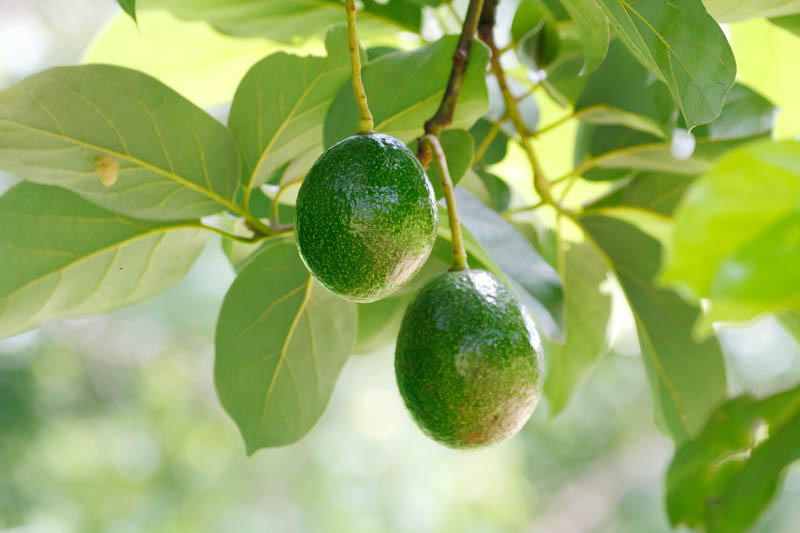
Avocado trees exhibit a unique flowering behavior known as “synchronous dichogamy,” which aids in pollination and is categorized into Type A and Type B. This mechanism involves the timing of the male and female phases of the flowers, which open at different times of the day and on different days to encourage cross-pollination by insects.
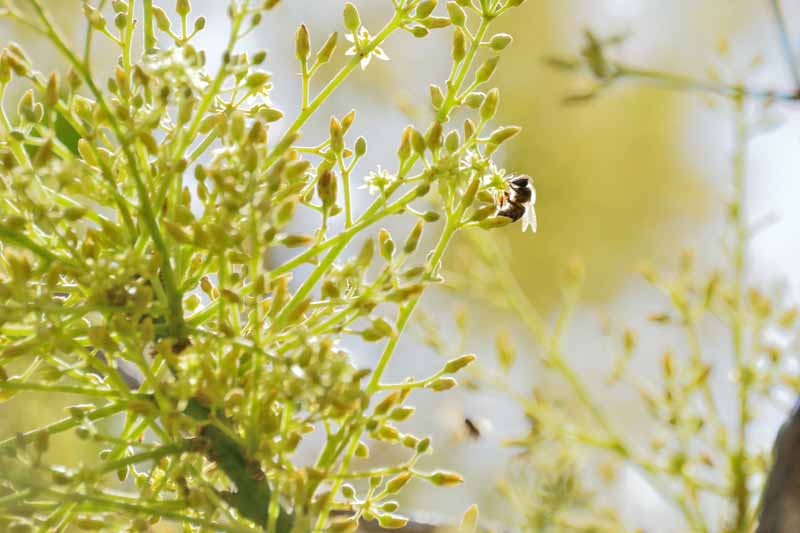
Bees actively contribute to the pollination of avocado flowers, playing a crucial role in the tree’s fruiting process
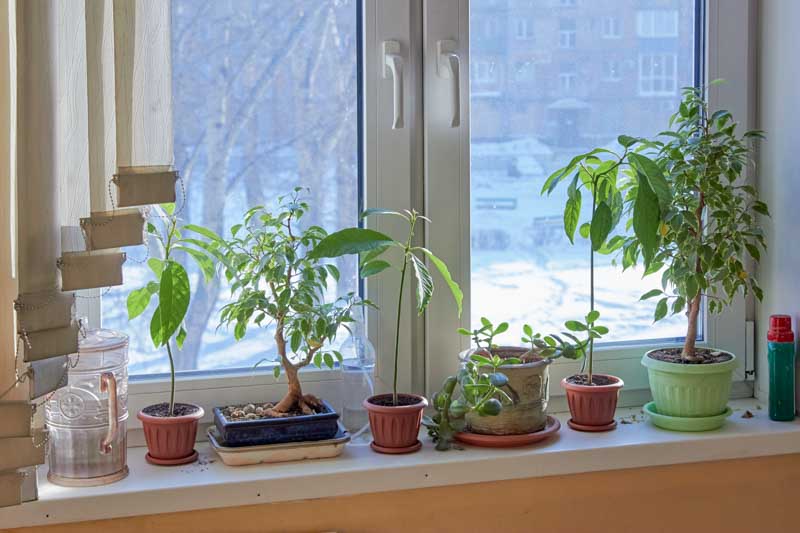
Avocado seedlings and ficus benjamina plants in pots
Harvesting avocados requires a bit of knowledge and timing to ensure you pick them when they are mature but before they overripe on the tree. Here’s a guide to harvesting avocados:
Know When to Harvest:
Look for Signs of Maturity:
Test Harvest:
Proper Picking:
Post-Harvest Handling:
Staggered Harvesting:
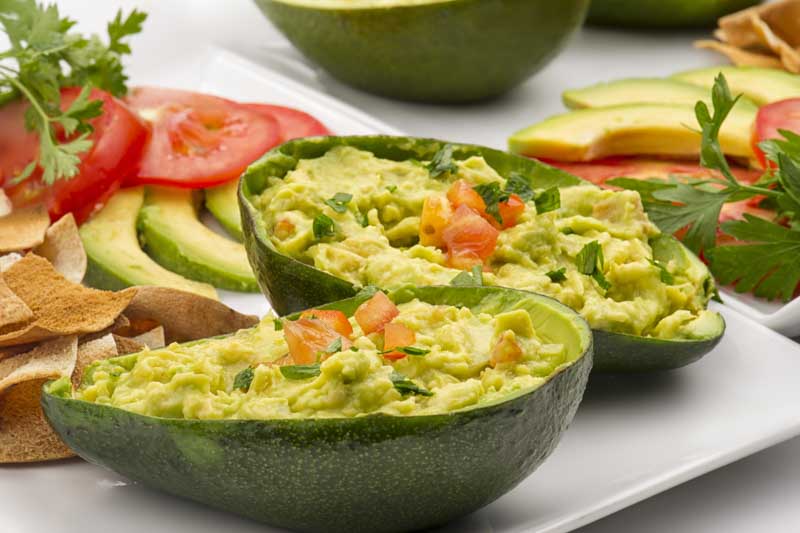
Avocado Boat Salad: A fresh, vibrant salad served in a hollowed-out avocado half
Avocado offers numerous health benefits due to its rich nutrient profile:
Nutrient-Rich: Avocados are high in vitamins K, C, E, B5, B6, and folate. They also contain moderate amounts of magnesium, manganese, copper, iron, zinc, phosphorous, Vitamin A, B1 (Thiamine), B2 (Riboflavin), and B3 (Niacin).
Heart Health: They are a great source of monounsaturated fatty acids, especially oleic acid, which have been linked to reduced inflammation and have beneficial effects on genes linked to cancer.
Fiber Content: High in fiber, avocados aid in digestion, help lower the risk of many diseases, and contribute to weight loss.
Lower Cholesterol and Triglyceride Levels: Studies have shown that avocados can significantly reduce total cholesterol levels, lower LDL (bad) cholesterol, and increase HDL (good) cholesterol, while also reducing blood triglycerides.
Eye Health: They contain antioxidants like Lutein and Zeaxanthin, which are vital for eye health and may reduce the risk of macular degeneration and cataracts.
Absorption of Other Nutrients: The fats in avocados can increase the absorption of fat-soluble vitamins like A, D, E, and K from other foods.
Weight Loss: Despite being high in calories, avocados may aid in weight loss by promoting satiety and reducing the desire to eat.
Bone Health: With high levels of Vitamin K, avocados contribute to bone health by increasing calcium absorption and reducing urinary excretion of calcium.
Cancer Prevention: Some research suggests that the nutrients in avocados may have benefits in preventing prostate cancer and lowering side effects of chemotherapy in some cells.
Skin and Hair Health: The natural oils and nutrients in avocados can nourish the skin and hair, making them popular ingredients in cosmetic products.
Antioxidant Properties: They are rich in antioxidants, which protect your cells from free radicals, potentially slowing down aging and reducing the risk of various diseases.
Anti-Inflammatory Properties: The monounsaturated fats in avocados have anti-inflammatory properties, which can benefit conditions like arthritis.
Blood Sugar Regulation: The healthy fats in avocados can stabilize blood sugar levels, which is beneficial for individuals with diabetes.
Overall, avocados are a versatile and nutrient-packed food, offering wide-ranging health benefits, making them a valuable addition to a balanced diet.
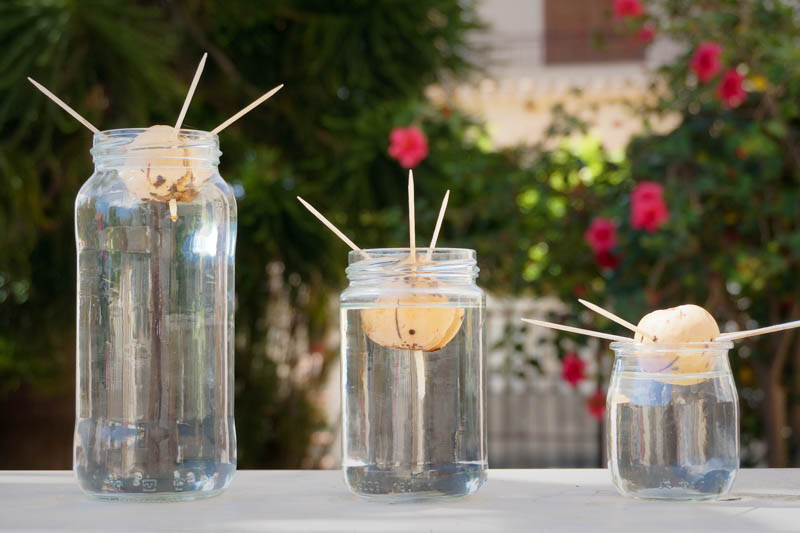
Three Avocado seeds growing roots in glass bottles
Propagating an avocado tree can be a rewarding experience. There are primarily two methods: seed propagation and grafting. Here’s how to do both:
Extract the Seed:
Prepare the Seed:
Germination:
Transplanting:
Choose a Rootstock and Scion:
Grafting Process:
Aftercare:
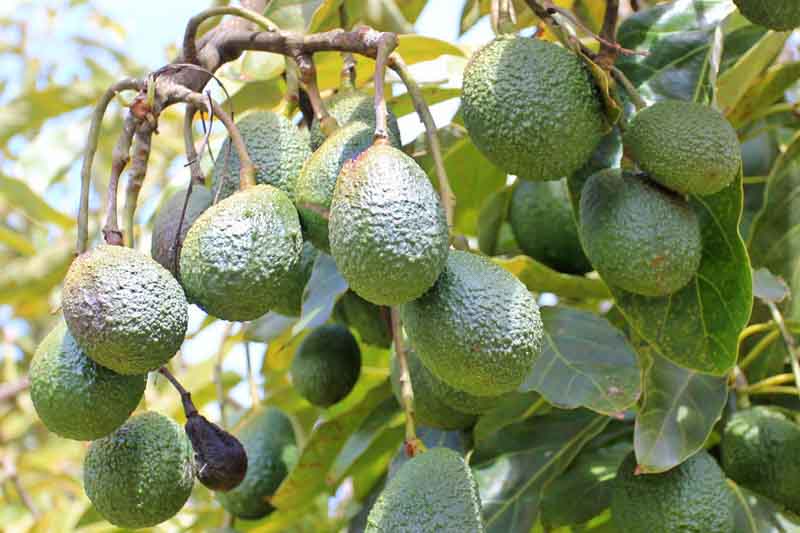
Hass avocado: a popular variety known for its creamy texture, nutty flavor, and pebbly, dark green to black skin.
Avocado Lace Bug: These small bugs feed on the underside of leaves, causing yellow blotches and potentially defoliation.
Borers: Certain borer species can infect the tree, leading to limb dieback and reduced tree health.
Thrips: Avocado thrips (Scirtothrips perseae) are tiny insects that damage avocado leaves, flowers, and fruit. They cause scarring and reduce fruit quality, making management essential in commercial avocado production.
Spider mites: These tiny pests can cause the yellowing or bronzing of leaves and lead to leaf drop.
Anthracnose: Caused by a fungus, this disease affects fruits, leading to dark spots or rot.
Cankers: These create lesions on branches and trunks, which can girdle limbs and cause dieback.
Root rot: This fungal disease is the most serious and common. It leads to root decay and leaf wilting and can kill the tree. Good drainage and resistant rootstocks are key to prevention.
Sunblotch: A viroid disease that results in yellowed, streaked branches and fruits and can reduce yield.
Poor Fruit Set: This can be due to a lack of pollination, excessive wind, or improper watering.
Water Stress: Both overwatering and underwatering can lead to problems, including root rot and poor fruit development.
Frost Damage: Young trees are particularly susceptible to frost damage. Protection or choosing frost-resistant varieties is important in cooler climates.
Nutrient Deficiencies: Symptoms like yellowing leaves or poor growth often indicate a lack of nutrients, requiring balanced fertilization.
How long does it take for an avocado tree to bear fruit?
Avocado trees typically begin to bear fruit in 3-5 years if grafted, while seed-grown trees may take 5-13 years or more. The exact time can vary based on the variety, growing conditions, and care.
Do you need 2 avocado trees to produce fruit?
While many avocado varieties can self-pollinate, having both Type A and Type B varieties nearby can enhance cross-pollination and potentially increase fruit yield.
Will a potted avocado tree bear fruit?
Yes, potted avocado trees can bear fruit, especially if they are grafted varieties. However, regular pruning and adequate pot size are crucial for their health and productivity.
Are avocado trees hard to take care of?
Avocado trees require moderate care. They need well-draining soil, regular watering, proper fertilization, and protection from cold. Regular monitoring is important because they can be susceptible to pests and diseases.
Do avocados grow well in pots?
Avocado trees, especially dwarf varieties, can grow in pots. The key is to provide a large enough pot, good soil, adequate water, and enough sunlight.
Do avocado trees need full sun?
Avocado trees need full sun to thrive — about 6-8 hours of direct sunlight per day is ideal.
What are avocados known for?
Avocados are known for their high content of healthy fats (particularly monounsaturated fats), fiber, vitamins (like vitamins E, K, C, and B vitamins), and minerals (such as potassium). They support heart health, aid digestion, and benefit skin and hair health. Avocados are versatile in cooking, used in dishes like guacamole, salads, sandwiches, and even in smoothies.
How often should you eat avocados?
There’s no strict guideline on how often you should eat avocados. However, moderate consumption is advised due to their high-calorie content (mainly from fats), fitting within your overall dietary needs and goals. For many, this might mean eating avocados several times a week.
| Hardiness |
8 - 11 |
|---|---|
| Plant Type | Houseplants, Fruits, Trees |
| Plant Family | Lauraceae |
| Common names | Avocado |
| Exposure | Full Sun |
| Season of Interest |
Spring (Early, Mid, Late) Summer (Early, Mid, Late) Fall Winter |
| Height |
30' - 60' (9.1m - 18.3m) |
| Spread |
20' - 30' (6.1m - 9.1m) |
| Maintenance | Low |
| Water Needs | Average |
| Soil Type | Loam, Sand |
| Soil pH | Acid, Neutral |
| Soil Drainage | Well-Drained, Moist but Well-Drained |
| Characteristics | Showy, Fruit & Berries, Evergreen |
| Attracts | Bees, Butterflies |
| Garden Uses | Beds And Borders, Patio And Containers |
| Garden Styles | Mediterranean Garden |
| Hardiness |
8 - 11 |
|---|---|
| Plant Type | Houseplants, Fruits, Trees |
| Plant Family | Lauraceae |
| Common names | Avocado |
| Exposure | Full Sun |
| Season of Interest |
Spring (Early, Mid, Late) Summer (Early, Mid, Late) Fall Winter |
| Height |
30' - 60' (9.1m - 18.3m) |
| Spread |
20' - 30' (6.1m - 9.1m) |
| Maintenance | Low |
| Water Needs | Average |
| Soil Type | Loam, Sand |
| Soil pH | Acid, Neutral |
| Soil Drainage | Well-Drained, Moist but Well-Drained |
| Characteristics | Showy, Fruit & Berries, Evergreen |
| Attracts | Bees, Butterflies |
| Garden Uses | Beds And Borders, Patio And Containers |
| Garden Styles | Mediterranean Garden |
How many Persea americana (Avocado Tree) do I need for my garden?
| Plant | Quantity | |
|---|---|---|
| Persea americana (Avocado Tree) | N/A | Buy Plants |
Create a membership account to save your garden designs and to view them on any device.
Becoming a contributing member of Gardenia is easy and can be done in just a few minutes. If you provide us with your name, email address and the payment of a modest $25 annual membership fee, you will become a full member, enabling you to design and save up to 25 of your garden design ideas.
Join now and start creating your dream garden!
Create a membership account to save your garden designs and to view them on any device.
Becoming a contributing member of Gardenia is easy and can be done in just a few minutes. If you provide us with your name, email address and the payment of a modest $25 annual membership fee, you will become a full member, enabling you to design and save up to 25 of your garden design ideas.
Join now and start creating your dream garden!